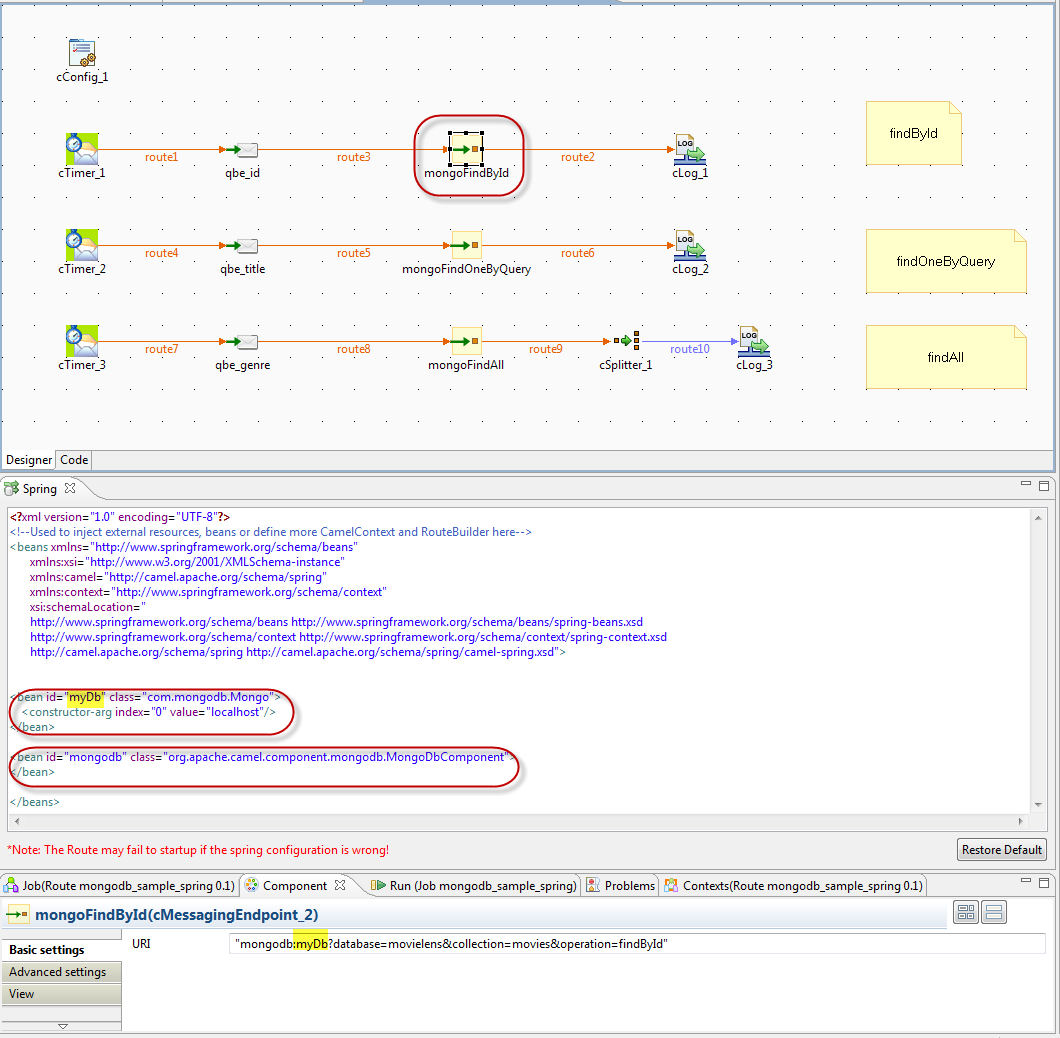Camel MongoDB in Talend Studio
Talend ESB provides an open source Talend Studio with a GUI designer for Apache Camel routes running in Apache Karaf.
While many Camel components are natively represented in the Mediation perspectives tool palette, many are not. In these cases the cMessagingEndpoint can be used as a general purpose component and configured with a URI. Additional work may be necessary to add the necessary jar dependencies as well as configuring the supporting camel Components in the Camel Context. This post walks through how to do this for the Camel MongoDB.
The sample route can be imported using Import Items in the Mediation perspective.
Install MongoDB and Talend Open Studio
Presumably you have installed MongoDB already.
Likewise you have hopefully already installed Talend Open Studio. It is just an xcopy install.
Import the movies into a movielens database
mongoimport --db movielens --collection movies --file movies.json
Download Camel Dependencies
First, find out which version of Camel is being used by your version of Talend Studio. Check the Talend Release Notes on help.talend.com and see the section titled ESB: Changes in Apache Projects. You may need to create and register a free account to use help.talend.com.
Once you know which version of Camel is in use by Tallend, determine which jars are necessary for the component you are interested in. In this example we are interested in MongoDB. The Camel MongoDB documentation shows the following:
<dependency>
<groupId>org.apache.camel</groupId>
<artifactId>camel-mongodb</artifactId>
<version>2.10.4</version> <!-- use the same version as your Camel core version -->
</dependency>
Talend Studo does not directly use Maven but we will to make sure that we have a single consistent place to store any jars we download, and so that all transitive jar dependencies are downloaded. Install Apache Maven if it is not already installed.
Now use maven from the commandline to download the desired dependency.
It will be installed in ~/.m2/repository/… in a path matching the group id, e.g. org/apache/camel
Be sure to use the same version as the Camel version identified above.
mvn dependency:get -Dartifact=org.apache.camel:camel-mongodb:2.10.4:jar -DrepoUrl=http://repo1.maven.org/maven2/
In this case you will also need a separate driver for MongoDB itself.
A quick search of Maven Central for mongodb and driver finds the latest entry.
Since this is not a Camel Component but a driver MongoDB itself, use the latest version.
mvn dependency:get -Dartifact=org.mongodb:mongo-java-driver:LATEST:jar -DrepoUrl=http://repo1.maven.org/maven2/
You have now downloaded all the dependencies you need.
Configure Studio Route to use Dependencies
These Library dependencies have to be added using the cConfig component.
Unfortunately, since Studio does not directly use Maven adding the full list of transitive dependency jars may be required.
Nor will it be obvious (short of checking the POM) which libraries are needed.
So a few iterations of compiling and adding dependencies may be needed.
- Create a new Route in Mediation Perspective.
- Add a cConfig Component.
- Add dependencies to the cConfig component.
In this case we will need three dependencies.
The two jar dependencies downloaded above can be added as External Modules.
An additional Internal Module is required which is the camel-jackson-alldep-2.10.4.jar.
The 2.10.4 corresponds to the Camel version in use by Studio.
Note that checking the versions of internal dependencies is a quick way to determine which version of Camel is being used by Studio.
Configure the Camel MongoDB Component
You now need to add and configure the Camel MongoDB component to the route using the dependencies we just added. This requires two parts.
- Create a MongoDB connection.
- Injected the MongoDB connection into a camel-mongodb Component.
This can be done with either Spring or a cBeanRegister component.
MongoDB Connection with Spring
- Use the Spring tab to create a bean for the MongoDB connection.
- Use the Spring tab to create a bean for the MongoDB Component.
-
The camel-mongodb Component acts as a factory for camel-mongodb endpoints specified in the route URI.
<bean id="myDb" class="com.mongodb.Mongo"> <constructor-arg index="0" value="localhost"/> </bean> <bean id="mongodb" class="org.apache.camel.component.mongodb.MongoDbComponent"> </bean>
MongoDB with cBean Register
- Add a cBeanRegister component to the canvass from the tool palette.
-
On the Component tab add some
Importsimport com.mongodb.Mongo; import java.net.UnknownHostException; -
On the Component tab add some
codeto create the mongodDB connection instance.Mongo mongodb; try { mongodb = new Mongo(context.mongoHost); } catch (UnknownHostException hostException) { throw new RuntimeException("Error connecting to MongoDB", hostException); } beanInstance = mongodb; - Add a cBeanRegister component to the canvass from the tool palette.
-
On the Component tab add some imports
import org.apache.camel.component.mongodb.MongoDbComponent; -
Now create the Camel Mongodb component.
MongoDbComponent mongodbComponent = new MongoDbComponent(); camelContext.addComponent("mongodb", mongodbComponent);
Create the Camel Route
- Create the route as shown below

- In all the examples the query is done by example based on the payload to the mongodb endpoint.
- The uri of the mongodb endpoint controls which method is invoked
-
The first queries by id
body: qbe id: 1 "mongodb:myDb?database=movielens&collection=movies&operation=<strong>findById</strong>" -
The second queries by the title field and uses the FindOne method to just return the first such element
body: qbe title: "{ title: \"Toy Story\" }" "mongodb:myDb?database=movielens&collection=movies&operation=<strong>findOneByQuery</strong>" -
The third queries by the genre and returns all matches
body: qbe genre: "{ genres: \"Children\" }" "mongodb:myDb?database=movielens&collection=movies&operation=<strong>findAll</strong>" - We split the third route to demonstratethat it returns multiple records from the mongodb endpoint.